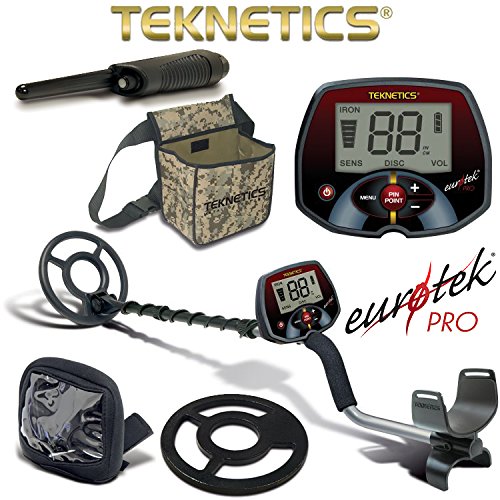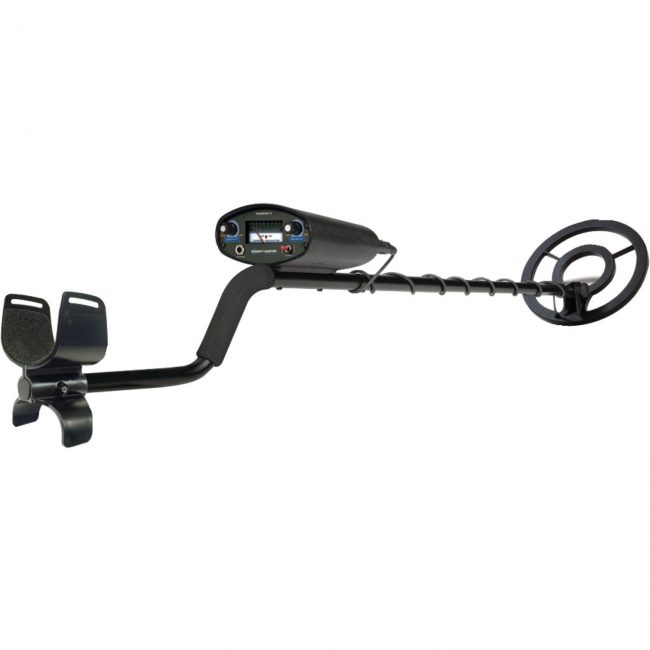CONTENTS

Who wouldn’t want to dig up buried treasure?
That’s the prime motivation for most people who are shopping for a metal detector, even though the likelihood of finding enough valuable items to retire – or even enough to pay a bill or two – is pretty slim. The more sensible reason for owning a metal detector is that it’s a lot of fun to search for stuff.
When you visualize one of these tools, you may picture a simple metal rod with a magnet on one end and a rudimentary set of controls on the other. Those units aren’t just products of your imagination; they exist, but they’re basically just toys for kids to play with. The best metal detectors are actually sophisticated electronic equipment which use advanced methods to find valuable items while ignoring trash.
As you’d probably expect, tools like that aren’t available in your local discount department store for ten or twenty bucks. Even a truly-effective metal detector for beginners might cost you $100 and professional models are priced well over $1,000. We usually don’t include professional equipment in our Your House Garden reviews, so you shouldn’t expect any of our choices for the top 5 best metal detector brand to cost you a month’s paycheck. There’s still a wide range of prices and features to consider, though, and in order to do that, you have to understand a little about how these devices work.
A Great Metal Detector Is Discriminating

There’s a small amount of treasure and an awful lot of trash buried in the ground, so the best metal detectors have to be able to tell the difference. They do it through a process known as discrimination, checking for the iron content of an item (iron is good, but lots of iron means you’ve probably found a bottle top and not a gemstone ring) and measuring their electrical conductivity (to distinguish between items like coins and soda can tops). Quality metal detectors feature many levels of discrimination, making them more precise.
The other important feature to look at is “ground balancing.” Minerals are naturally distributed in the soil of most areas you’ll be searching, so you’ll want your metal detector to ignore them and focus on “unnatural” objects in the ground. Less-expensive models will have a fixed ground balance already pre-set, while medium-priced models usually have an automatic ground balance feature. Higher-end units let you set the ground balance manually, a procedure which can be delicate and time-consuming but also the most effective way to find treasure.
How Metal Detectors Work
Magnets and Coils
There really are “magnets” at the business end of a metal detector. They’re electromagnetic coils in the shape of rings or other designs, and their purpose is to detect the magnetic fields that metal objects create in the ground.
1. Inexpensive models use round, concentric coils. The outside coil generates low-frequency signals known as VLF or induction balance signals. They create a search field which measures the electrical resistance and magnetic induction of any objects that are found, and the inside coil then transmits the results back to the detector. There are two major drawbacks to this approach:
– First, the search field that’s created by the outer coil is cone-shaped, so anything buried deep in the ground will go undetected unless the tip of the cone happens to hit it directly.
– Second, the top of the cone is so wide that it’s difficult for the electronics to sort out all of the items that are close to the surface.
2. Better metal detectors have “DD coils.” These look like opposing “capital D’s” and the search field they send out is narrow and blade-shaped for more precise work. The field can “dig” deeper and is wider at the bottom, making the discovery of buried items more likely. It’s also narrower at the top so discrimination becomes easier.
Controls and Alarms
Controls and alarms will be handled by the electronics at the top of the detector. The most important alarms, of course, tell you whether you’ve hit the jackpot; notification systems vary according to the metal detector’s quality level.
1. Inexpensive units will only sound tones depending on the general size and type of treasure that’s been found.
2. Higher-level models also use a technology called “target ID,” which does a much better job of distinguishing between different types of metals.
3. Moderately-priced detectors will have a meter or LED display, and the best metal detectors have alpha-numeric readouts which display the exact identification of the metal that’s been found.
Other Metal Detector Features
The technology built into a metal detector, and its overall performance, are by far the most important factors to consider when shopping. A few other features are also worth checking, though.
An adjustable rod is desirable since it will allow you to tailor the length of your detector to your height; a support that rests against your arm (known as a stabilizer) to keep the unit from shaking or twisting as you scan is also a terrific help. Easy-to-use controls to specify the target IDs you’re looking for, or to adjust functions like ground balancing, are a definite plus. And if your unit sends audio alarms you’re going to want a headphone jack.
Enough junk. Let’s get to the treasure (which is the Your House Garden list of the top 5 metal detectors comparison).
1. Garrett AT Pro Metal Detector

The AT Pro isn’t a true professional model, but it comes awfully close at a reasonable price (think hundreds of dollars instead of thousands). It’s lightweight and the shaft can extend from 42 to 51 inches, so it’s a joy to use. And it has just about every feature you could ever want.
This detector comes with an 8-inch DD coil which is perfect for searching for buried metal, particularly in areas with lots of trash (you can buy a smaller coil suitable for gold prospecting separately), and you can choose between automatic and manual ground balancing.
You can adjust the amount of iron discrimination and the notch function lets you easily set ranges of discrimination for your search, both useful in eliminating false positives.
And there are six modes of operation, three for beginners and three for experienced users who want better audio signals and faster recovery time between searches.
The readouts are shown on a terrific control panel which, for some reason, has no backlight – one of the few negatives we found on the AT Pro. It’s where you manage everything from discrimination and sensitivity to audio settings and it features digital target ID and depth readouts. Those audio settings are cool because the “iron audio” option lets you screen out alerts for trash and objects you’re not interested in and “proportional audio” has many different sounds representing the characteristics of all objects in the ground.
One more feature you won’t find on many metal detectors in this price range: it’s waterproof. The included headphones can’t be used underwater but everything else on this unit can, to a depth of ten feet. If we had to find another drawback to this model it’s that the field doesn’t go quite as deep as we’d like, but that’s about it.
The Your House Garden review team believes the Garrett AT Pro is, by far, the best metal detector you can buy without spending well over a thousand dollars. It combines outstanding performance with exceptional controllability and is a lot easier to figure out and use effectively than you’d imagine. Facts and figures on the Garrett AT Pro Metal Detector:
|
2. Fisher F4 Metal Detector

Here’s an option that’s priced a couple of hundred dollars lower than the AT Pro, but gives you almost everything the Garrett does except for some of the audio alert functions and the ability to go underwater.
The Fisher F4 has a very large 11” DD coil that does a great job of detecting down to ten inches, and you can choose between automatic and manual ground balancing.
There is custom notch capability along with sensitivity and threshold controls, and the unit has simple audio alerts (rather than the advanced ones available on the AT Pro) a graphic target ID scale, a numerical target ID readout and a depth indicator.
Those all combine to let you find just about any metal and tell you exactly what you’ve found.
The Fisher F4 isn’t quite as comfortable as the AT Pro to use for long stretches. That one objection aside, it’s a great lower-priced DD-coil alternative as long as you don’t care about advanced sound alerts or searching underwater. More detail on the Fisher F4 Metal Detector:
|
3. Teknetics EuroTek Pro

Here’s one more very good option with an 11” DD coil from a manufacturer known for its quality metal detectors. The EuroTek doesn’t have all of bells and whistles of the top two entries on our Your House Garden list of the top 5 best metal detectors, but it has much of what you’ll need to go hunting for coins and metal.
There are tone alerts and a numerical display for target ID, a sensitivity control and pinpoint mode, although there are no options for notch settings or manual ground balance adjustments.
We were surprised to find an iron audio adjustment option on this Teknetics detector, but found that it’s not really similar to the one on the (much) higher priced AT Pro; it simply can be set to “sound louder” when passing over iron. That’s not a huge deal, but it helps as you scan. The control panel is extremely user-friendly, too.
The presence of a large DD coil makes up for a lot with the Teknetics EuroTek Pro, which doesn’t have the full functionality of the metal detectors above it in our rankings but is still capable of finding lots of cool stuff deep in the ground for a reasonable price. Digging deeper on the Teknetics EuroTek Pro:
|
4. Tesoro Silver uMax Metal Detector

The Silver uMax looks a bit odd at first glance. The user panel has just two knobs and a toggle switch. There isn’t a DD coil or even standard concentric circular coils at the other end, either; it looks like a DVD with a hole in the middle is attached to the shaft.
In reality, there are concentric coils inside the “donut” and the performance of this Tesoro is surprisingly good despite the lack of fancy displays or digital controls.
The knobs let you select the sensitivity level, and the discrimination level and type. The toggle switch lets you choose between all-metal and discrimination mode. There’s just one tone that sounds when metal is detected. And – that’s it. But that’s all you need for some great treasure hunting.
The Silver uMax is likely to do a better job than many more expensive units with all the options, and the design and light weight of Tesoro metal detectors makes them incredibly comfortable and enjoyable to use.
The Tesoro Silver uMax is expensive for a concentric coil model but its performance is almost as good as a detector with a DD coil, with a lower price tag. That’s why many treasure hunters insist on Tesoros instead of fancier competitors. Specs for the Tesoro Silver uMax Metal Detector:
|
5. Bounty Hunter TK4 Tracker IV

Those who have been stunned by the fact that the best metal detectors can cost hundreds of dollars are about to be rewarded for their patience. The Bounty Hunter TK4 is perfect for novices, buying their first hobby metal detector because it performs well, it gives you a number of settings to play around with as you learn – and yes you can afford it.
Here’s what you’ll find on the TK4: 8” concentric coils, audio alerts and a target ID meter, discrimination and sensitivity controls, and an all-metal mode. You can’t manually adjust settings like ground balance, and there are no digital readouts or advanced features – but you shouldn’t expect them for this price.
This is an entry-level model, and it’s the best of the bunch in that category.
You’re not going to find every coin that one of our higher-ranked detectors will pick up, but the Bounty Hunter TK4 is much more than a toy and a great way to get into the hobby of metal detecting, for a price that’s extremely reasonable. More information on the Bounty Hunter TK4 Tracker IV:
|
If you are going to really commit to finding that elusive pot of gold then you might have to search in remote places where others rarely venture. To do this you will probably have to equip yourself with a quality sleeping bag and tent – enjoy the adventure.


SAKOBS metal detector is also a good choice, we can’t find it on your website. I have trouble sending the email to you through the “contact” button on the website. How can I contact you? Could you let me know your email?
I have used TITAN GER 1000 from GER DETECT Company
I think it works very efficiently, I hope to include it in your list
I never hear anything on Whites Poducts. I’ve been Metal Detecting for 10 years and I use the MXT, MXT, Pro and MXSport. I’m just learning the Mxsport and have had and still having a lot of success with my MXT and MXT Pro. I live in Nevada just curious with all the videos I watch and stories I read very rarely do I see anyone or read about anyone using a Whites Detector. Will say The Garrett’s pin pointer is the best. Thank You for your article
Hiya W Cazier,
Thanks for the comment, we just spent a bit of time checking out Whites Metal detectors and they do certainly look like very high-quality products.
For those who are interested please check out the MX7 on Amazon via this link -> https://geni.us/whites_mx7
Kind Regards,
Pierce
Great read thanks
No problem Tim, glad you enjoyed it, and hopefully it was also helpful…
Kind Regards,
Pierce